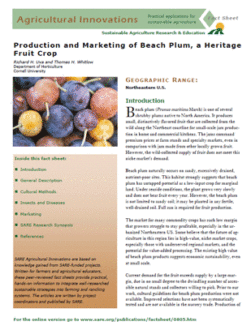Food Industry Trade Shows
We exhibited at the New England Foodservice & Lodging Exposition and Conference, April 10-12, 2005, at the Boston Convention & Exhibition Center. Thousands of people saw the booth and we had over 200 conversations about beach plum fruit and products. Many were familiar with beach plum and were overjoyed that this local food is now available. We met with two major specialty produce purveyors in the region who want fruit and would be willing to test market small quantities. High price points were suggested. Several chefs, small processors and gourmet product retailers were interested in getting product. The SARE logo was recognized by two of the chefs who are interested in local food and sustainable agriculture.
We also exhibited at the United Fresh Fruit and Vegetable Association’s 2005 Produce Expo & Conference, in conjunction with Food Market Institute Show, U.S. Food Export Showcase, the Fancy Food Show, and All Things Organic, May 1-3, 2005, at Lakeside Center at McCormick Place in Chicago, Ill. The total tradeshow attendance was 30,000, and we had more than 100 booth participations. While the booth attendance number in Chicago was lower than the New England show, the quality of interested individuals who have the resources to grow the industry sector was significant. Two mid-Atlantic produce distributors were interested in fresh fruit for their product line. We also met with two primary national specialty produce companies, and they were both interested in working with growers to develop the market. One has scheduled a grower visit to the Northeast.
Marketing Opportunities for Growers
To capture the gourmet consumer market in coastal metropolitan areas, beach plum product marketers could first target independent retailers, gourmet food stores or farm markets, but not major supermarkets. To present to consumers that the beach plum product is special and gourmet, packaging and price should be designed to reflect that image. Once consumers purchased and tried the product for the first time, quality and taste are the most important factors for return purchases. Gourmet consumers are interested in new products and willing to pay a premium price for them. To sustain this market interest, beach plum product producers should build on high quality jams and jellies and develop complementary new products.
To enter the food service market, beach plum marketers should first identify cutting-edge operations and individuals in this market, such as high-end restaurants that have unusual menus and gourmet chefs who are innovative and willing to try new things. Initial contacts with restaurants should be done directly with chefs and not through produce wholesalers. Providing different forms of product samples such as fresh and frozen fruits in whole and pitted forms for chefs to test recipes is an effective way to establish interest. Work with chefs to develop new recipes and provide them with beach plum lore and publicity that they can use to promote the product on their menus to differentiate their dishes. Chefs tend to use beach plum as sauce or garnish for their premium priced entree dishes or appetizers, so they are willing to pay a premium price for the product, but the volume will be smaller. On the other hand, bakery chefs need higher volumes of fruit for their recipes, and they are more concerned about price of the fruit and the labor involved in pitting the fruit. When selling to food service customers, the key is to make contacts with restaurants a few months before harvest, so the chefs can plan their menus and promotion accordingly and work out a viable delivery system. It is important to maintain consistent seasonal supply, high fruit quality and adequate quantities.
Another potential market for beach plum fruit and products are wholesale food distributors. Specialty produce purveyors are often willing to test market with small quantities. Initial contact could be done directly with product samples. In addition to product features, native & sustainable are two other attributes that could be used to promote beach plum. Due to the seasonal nature, clear communication about harvest time, quantity and quality will be very important.
Our experience at the food industry trade shows demonstrated that chefs, small processors, gourmet food retailers, and specialty produce wholesalers are the ones who would be more interested in purchasing beach plum fruits and products. All parties at this stage of beach plum market development show interest in premium fruit and fruit products that would generate relative high returns to growers. Growers should have a clear understanding of the market potential and premium price point. This should help clarify and support the need of continuous development of a grower network as the industry sector develops.
